I’m kind of obsessed with having the perfect ultralight backpacking gear setup…
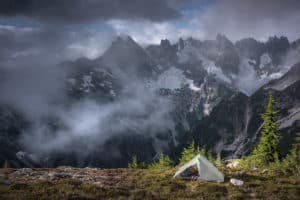
I have used all of this gear extensively for 100+ days & nights.
Skip the trial and error and hit the backcountry with some of the very best gear available.
Page Contents
- Ultralight Backpacking Videos
- Backpack
- Backpacking Shelters That I Choose
- Sleep Stuff – Quilt, Air Pad, Pillow, & More
- Food + Storage, Water Filter & Bags, Cooking Gear
- Small Backpacking Essentials
- My Favorite Hiking Clothes
- Ultralight Footwear for Backpackers
- The Ultimate Trekking Pole
- Snow & Winter Gear to Supplement 3 Season Hikers
Ultralight Backpacking Videos
Consider watching these videos before reading this guide.
A breakdown of my backpacking essentials.
Learn about the backpacking clothing layers that I find to be the very best.
Don’t have time to read the whole guide right now?
No worries. Let me send you a free PDF copy so you can read it when it’s most convenient for you 🙂
Emails are never shared. Unsubscribe at any time.
Backpack
Hyperlite 4400 Southwest–2.45 lbs-
PROS: 70 liters in size. Lightweight. Virtually waterproof. Handles heavy loads comfortably. Made in the USA.
Its constructed out of Dyneema, which is 15 times stronger than steel & the fabric itself is 100% waterproof.
CONS: No ventilation on the back panel.
Trash Compactor Sack -2oz-
I line the inside of my bag with a trash compactor sack to fully protect my gear from the water.
I find this to be much more effective than a backpack cover.
This is ESPECIALLY IMPORTANT if I’m pack rafting or fording rivers.
Backpacking Shelters That I Choose
Zpacks Duplex Tent –19 oz-
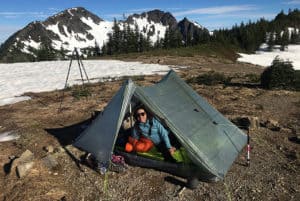
PROS: Extremely lightweight. Doors and vestibules on both sides. Incredibly spacious. Waterproof bathtub floor. Sweet views. 1-year warranty.
Unlike Silnylon, the Dyneema it’s constructed from stays taught after setup.
CONS: Expensive. Not freestanding. It can be difficult to set up on rocky surfaces. Condensation can build up easily on inside walls.
Hubba Hubba NXT Tent -3lbs 7oz-
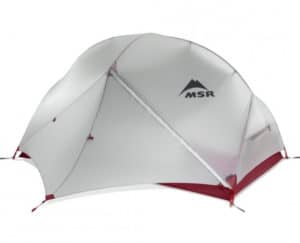
PROS: I’ve used this shelter extensively for about 4 years now. Well ventilated, freestanding, easy to set up, spacious, doors and vestibules on both sides.
CONS: Not the lightest.
Tent Footprint -7oz-
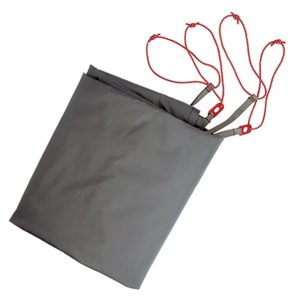
PROS: Protects the bottom of your tent. Provides an extra moisture barrier.
CONS: Extra Weight.
I only use my groundsheet if I’m going to be camping directly on the snow. Otherwise, I feel like it’s not really needed and is unnecessary weight.
MSR Groundhog Stakes -.5oz each-
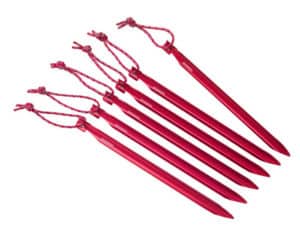
PROS: I Haven’t had one of these pull out on me yet. I’ve experimented with many different tent stakes, and I have found these to hold the best overall in most conditions. They also won’t bend or break on you.
CONS: Not the lightest
MLD Superlight Solo Bivy -6 oz-
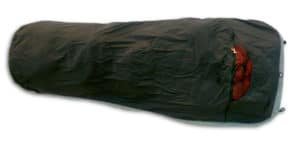
PROS: Small footprint. It helps eliminate drafts when using a quilt. It keeps me from rolling off of my pad. It adds 10 degrees of warmth to my sleeping setup. It can be staked to the ground while cowboy camping & keeps the bugs & condensation off me.
CONS: Another piece of gear to add to the collection.
Sleep Stuff – Quilt, Air Pad, Pillow, & More
Therm-a-Rest Neo Air X-lite -12 oz-
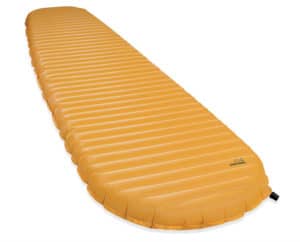
PROS: Lightweight, comfortable, and durable. Packs down extremely small. Easy to patch in the field. Doubles as a makeshift raft. I have been using this pad since 2011. Probably the oldest piece of gear I own.
CONS: Kind of noisy when you roll around.
Gossamer Gear Foam Pad -3 oz-
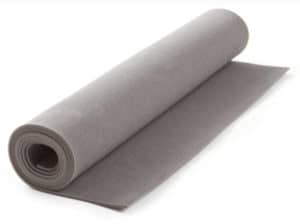
PROS: Just an awesome lightweight, super-thin foam pad. I bring this as a supplement to my Neo Air in colder conditions.
CONS: Tears easily.
Sea to Summit Pillow -2.8 oz-
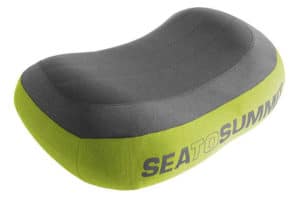
PROS: Soft outer material. Extremely comfortable.
I cannot sleep well without a proper pillow. Spare clothes in a stuff sack just won’t do it for me. This thing comes on all of my trips.
CONS: Extra weight.
Enlightened Equipment Enigma Quilts
PROS: I love this quilt so much. Extremely warm, lightweight, and customizable. Filled with treated DownTek. Made in the U.S.A.
CONS: 4-6 week wait time.
Food + Storage, Water Filter & Bags, Cooking Gear
Jetboil MiniMo Stove -14 oz-
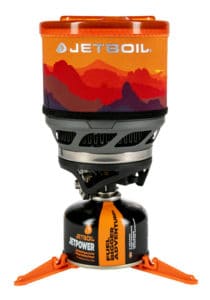
PROS: I’ve cooked 100’s of meals in my Jetboil. It is versatile, easy to use, fuel-efficient, simmer, and insulated.
CONS: The igniter will stop working on your Jetboil if you use it enough. Not a huge deal; you just have to use a lighter to get it started.
Long Wooden Spoon -.5 oz-

PROS: The long length makes getting to the bottom of your Jetboil or freeze-dried meal very convenient.
CONS: Blends into the outdoor surroundings making it easy to leave behind.
Assorted Nalgene Containers -1 oz-
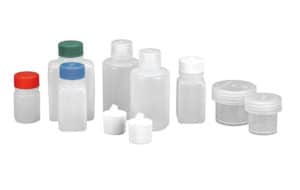
PROS: Assorted sizes, leakproof.
These are great for carrying salt & pepper, olive oil, hot sauce, toothpaste, sunscreen, & whatever else you might want to put in a little bottle.
CONS: What could be bad about these?
12″ x 20″ Loksak Opsak -1 oz-
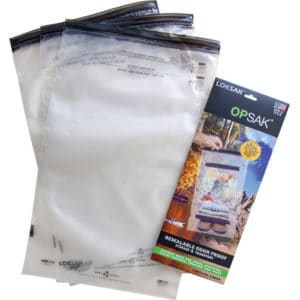
PROS: Scent proof, clear. If an animal can’t smell your food, to begin with, you’re ahead of the game.
The 12″ x 20″ size can carry up to 7 days of food & is ideal for pairing with an Ursack bear b
CONS: I have to replace them ever so often.
Ursack Bear Bag -7.6 oz-
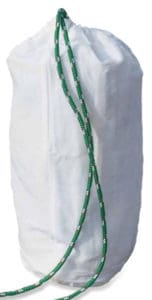
PROS: Keeps rodents and bears from being able to get into your food. Lighter than a bear can. Easy to use.
CONS: Heavier than a regular stuff sack. While a bear can’t get into this bag, it can still smash up all of your food.
WARRANTY: Lifetime.
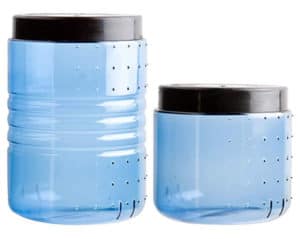
BV450 -33 oz-
BV500 -41 oz-
PROS: Bears & rodents can’t get into them. Doubles as a camp chair. Transparent design helps you see all of your food.
I can fit up to 8 days worth of food in my BV500.
& up to 4 days’ worth of food in my BV450.
CONS: HEAVY.
Be the first to know when I release new free backpacking guides 🙂
Emails are never shared. Unsubscribe at any time.
1 Liter Smartwater Bottle -1.5 oz-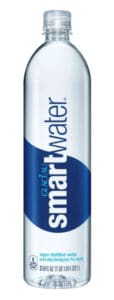
PROS: lightweight, cheap, & reusable. The only bottle I take on the trail. I really like its tall, slender design. It feels good in the hand and is easy to grab from the side of my pack.
A Sawyer water filter can screw directly onto the top.
CONS: Made by Coca-Cola
2 Liter Evernew Water Bag -1.5 oz-
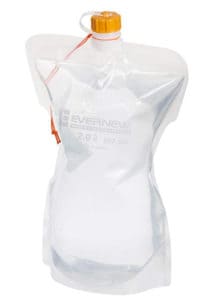
PROS: lightweight, transparent, takes up little space when empty. These bags are MUCH more durable & dependable than the Sawyer bags.
I carry 2 of these on almost all of my trips.
This allows me to carry 5 liters of water if need be. Having 2 also gives me a backup in case one fails.
CONS: I’ve had these bags break after extensive use. I haven’t been able to find a more durable lightweight bag, though.
WARRANTY: 1 year.
Sawyer Squeeze Water Filter -3 oz-
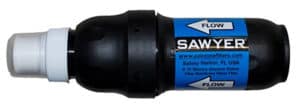
PROS: Durable, dependable, lightweight. This water filter is BOMBPROOF.
I have been using this filter primarily for about 8 years now. The filter will slow down over time, even if you back-flush often. I replace mine after about 150 days of use.
CONS: Filter will slow down over time. It can be ruined in freezing temps.
WARRANTY: Lifetime.
Aquamira Purification Drops -2 oz-
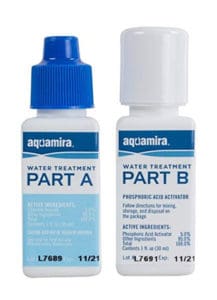
PROS: Effective on viruses, no after taste, lightweight.
CONS: Have to wait 15-30 minutes before drinking your water and adding chemicals to your water.
I rarely use this stuff. I never need it up here in the Pacific Northwest. I will use this on some of the nastier water I have to drink in the Southwest.
Small Backpacking Essentials
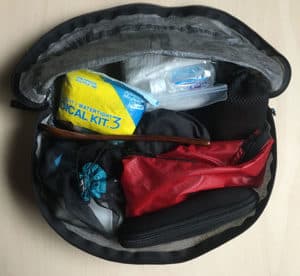
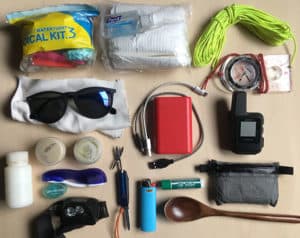
Sea to Summit 2.5 liter mesh stuff sack -.2 oz-
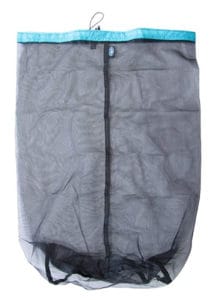
PROS: Lightweight, see-thru, easy access drawstring.
I keep my headlamp, toothbrush, toothpaste, floss, chapstick, sunscreen & mini Swiss Army knife in this bag. Stuff I need on a daily.
CONS: After 5 years of use, I had to replace this bag after getting a hole in the sack’s bottom.
Garmin inReach Mini-3.5 oz-
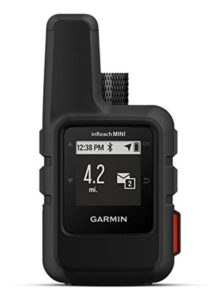
PROS: Can save someone’s life, lightweight, small, GPS, texting capabilities.
Since I purchased my Garmin, it has already been used to save someone’s life.
CONS: Have to pay for a service plan.
Petzl Actik Core Headlamp -2.8- oz-
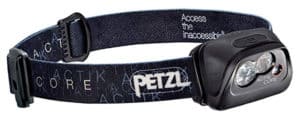
PROS: Rechargeable USB battery, dependable, adjustable lumens, red light, and AAA batteries.
I’ve burned through many “HIGH QUALITY” headlamps in the past. I’ve had Black Diamond & Princeton Tec headlamps fail on me.
I have been using this extensively for over two years now and am still using the original USB battery it came with.
CONS: Headband starts to stretch out.
Anker External Charger -6.35 oz-
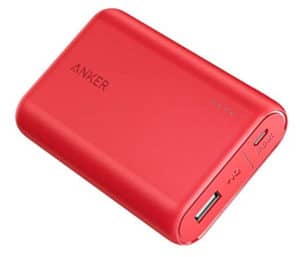
PROS: Small, dependable, can fully charge a phone over 3 times.
I use this to recharge my headlamp, phone, and GoPro batteries.
For all trips under one week, this thing has more than enough juice for me.
CONS: 6 extra ounces in the bag.
Mini iPhone Cords 8″ -.1 oz-
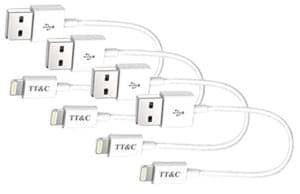
PROS: Small length, lightweight.
I carry two of these in my external charger case. One extra in case one fails. I always keep them there, so I don’t lose them or leave them at home.
CONS: Made by a third party.
Suunto M-3 G Compass-1.5 oz-
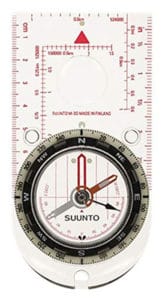
PROS: Can set declination, luminescent markings make for easy reading in low light, very accurate.
This compass has saved me a few times.
CONS: No sighting mirror. This may or may not be a con for you. Personally, a sighting mirror isn’t worth the extra weight for me.
50′ 2.0 mm Z-line Dyneema Cord -1.7 oz-
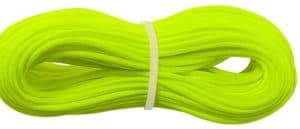
PROS: Strong strength to weight ratio, bright color makes it easy to see, easy to tie and untie knots, doesn’t tangle very easily.
I find size 550 paracord to be overkill for what I do. I prefer this & use it to hang my food, lower my pack down steep inclines, & many other random tasks. I always carry this with me.
CONS: Only one color.
Mini Swiss Army Knife -.8 oz-
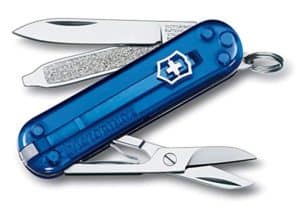
PROS: lightweight, insanely useful, versatile.
The scissors are great for cutting open packages, tape, patches & moleskin. The small knife gets most jobs done. The tweezers are also handy.
CONS: It’s minimal, making it easy to lose possibly.
Morakniv Fixed Blade Knife -4.1 oz-
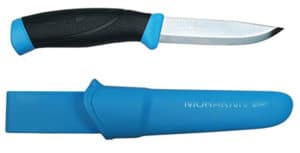
PROS: Fixed blade, high quality, low price.
CONS: Heavier than my Mini Swiss Army Knife.
I only bring this knife with me if I plan to have a fire in wet conditions and process wood.
I was using a slightly smaller Mora Light My Fire Knife for years until it recently broke on me. I decided to go with something a little bit stronger.
Antimicrobial Toothbrush -.5 oz-

PROS: Compact, lightweight, antimicrobial, floss-like bristles.
This is the best backpacking toothbrush ever.
CONS: The inside of the handle can be hard to clean.
Carfia Polarized Sunglasses -1 oz-
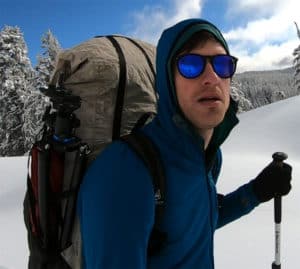
PROS: 20 dollars, polarized, 100% UV protection. They will look better on you than me.
CONS: Plastic lenses.
Neoprene Sunglass Case -1 oz-
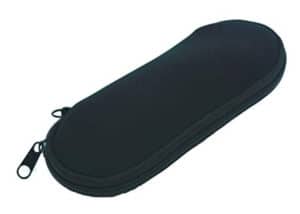
PROS: Lightweight, minimalistic, protects my sunglasses.
This was the lightest, most minimalistic sunglass case I could find that offered enough protection. I carry a small microfiber cloth I wrap around my shades to protect them and clean them when need be.
CONS: Not crushproof protection.
Adventure.3 First Aid Kit -2.5 oz-
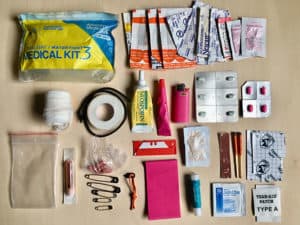
PROS: Lightweight, watertight, compact.
CONS: Very minimalistic. It could be a con for some.
I’ve had this same kit since 2012. I don’t really ever use it. I guess I have been pretty lucky so far. Still, always carry it with me.
I’ve added a few things to my personal kit.
- Ibuprofen
- Anti-Diarrheal Pills (Imodium)
- Antihistamine Pills
- Super Glue
- Neosporin
- Safety Pins
- Electrolyte Tablets
- Ceramic Utility Blade
- Sewing Needle
I always carry a small container of Natures Divine Botanica Wilderness First Aid Balm. I mostly use this for sunburn, dry skin & chapped lips if need be. Can also be used for healing wounds or bug bites.
(Disclaimer: These first aid items are what I carry. I’m not specifically recommending them to others. Be sure to consult with your physician before taking any medication)
Tenacious Tape -.1 oz-
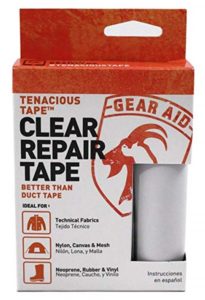
PROS: Lightweight, versatile, holds up even after washing.
I’ve used this on countless occasions to patch small holes in my jackets or pants on the spot.
CONS: Duct tape isn’t my main squeeze anymore.
Therm-a-Rest Z Seat -2 oz-
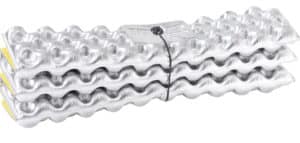
PROS: Compact, lightweight.
This is starting to become one of my favorite pieces of gear. It keeps your butt warm and dry. Especially nice in the snow.
CONS: Ugly yellow & Silver color combo.
My Favorite Hiking Clothes
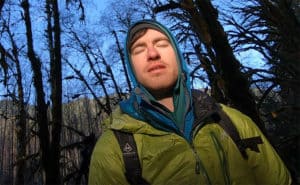
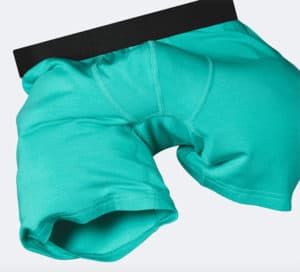
PROS: Extremely soft & comfortable, antimicrobial, long-lasting.
I’m always wearing a pair of these while backpacking. They hug the legs tightly, preventing chafing & are better than any synthetic underwear on the market.
I purchased 4 pairs of these a year ago, and they have been worn every day since—no holes or tears. The durability of these is no joke.
I LOVE them so much! I even wrote a comprehensive article about MeUndies boxers.
CONS: None!
These are better in every possible way.
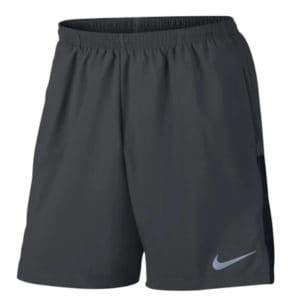
PROS: Can’t beat the comfort and flexibility of a nice pair of thigh highs. Great for swimming. Dry out fast.
CONS: No sun protection for the legs.
75% of the year, I’m hiking in my Nike shorts. I always cut the liner out of the inside.
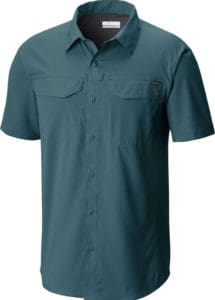
PROS: UPF 40 Protection. Ventilation on the back. Looks nice enough to wear on a date.
Best hiking button up out there.
CONS: It doesn’t fully protect your lower arms.
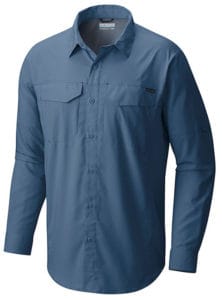
PROS: Same as the short sleeve + full arm protection.
CONS: Arms don’t feel as free as they do while wearing a short sleeve.
If I were a little bit smarter, I’d always wear a long sleeve to protect my arms from the sun. This shirt is my go-to when I need bug protection.
I can’t say enough good things about these shirts.
Mont-bell Dynamo Wind Pants -2.7 oz-
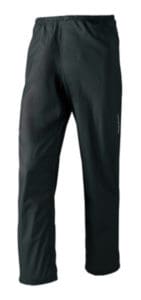
PROS: Insanely light and comfortable. Highly breathable.
Usually, these are the only pants I bring outside of my SmartWool bottoms in the warmer months. They offer great protection from the sun and bugs.
They also provide quite a bit of additional warmth when the temperatures drop or the winds pick up.
CONS: No front pockets. Tear very easily.
SmartWool 150 leggings-5.6 oz-
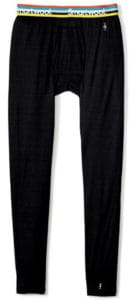
PROS: Antimicrobial, moisture-wicking, warm.
I always have a pair of these in my bag. They redesigned these recently, and they seem to be much more durable than the previous pair I had.
CONS: Can tear easily.
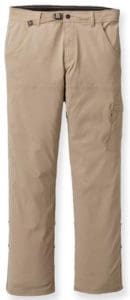
PROS: Stretchy, built-in belt, nice fit. They come in long lengths.
CONS: Personally, I wish the material was a bit thinner.
I find hiking pants to be restricting and uncomfortable.
I just picked up a pair of these for off-trail hiking, though. Going to try and give the legs a break from getting torn up while bushwhacking.
I Will let ya guys know more about what I think after getting them out on a few test runs.
Marmot Polartec Hoody-8 oz-
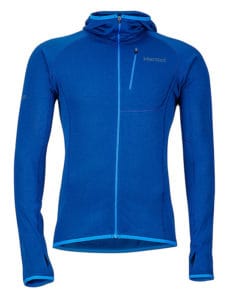
PROS: Comfortable, warm, and versatile. Hooded. Chest Pocket.
CONS: Not available anymore.
Patagonia R1 Hooded Fleece -13 oz-
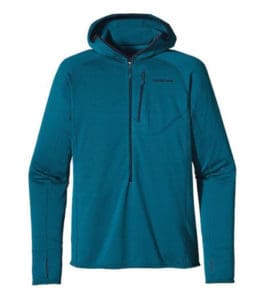
PROS: Extremely warm, comfortable, 1/4 zip, chest pocket, and a hood.
I’ve worn my R1 a good 300 plus days since I purchased it 4 years ago. This thing is standing the test of time.
CONS: Not as versatile as the fleece mentioned above.
Ghost Whisperer Hooded Down Jacket-7.8 oz-
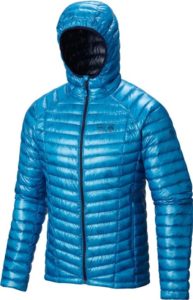
PROS: Lightest full-featured down jacket available. Filled with water-resistant treated down. Has pockets and a nice fitting hood.
This is always in my bag. I love this thing. Incredibly warm for a sub-8-ounce jacket.
CONS: The outer material is pretty thin. It could tear pretty easily.
Outdoor Research Helium Jacket -7.2 oz-
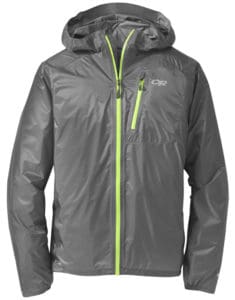
PROS: One of the lightest rain jackets available. Highly breathable.
This jacket is in my bag all year. Makes for a great windbreaker as well.
CONS: No pit zips.
Outdoor Research Helium Pants-5.4 oz-
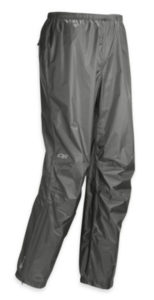
PROS: One of the lightest pairs of rain pants available. Highly breathable. Zippers on the bottoms enable you to take these on and off without taking your shoes off.
CONS: Made of a pretty thin material that can tear easily.
That said, they stand behind their lifetime warranty.
Six Moons Umbrella -8.9 oz-
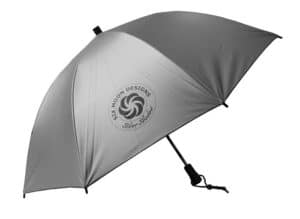
PROS: One of the best forms of rain protection. It has a silver surface that reflects the sun up and provides excellent shade in extreme conditions.
This thing is a game-changer & one of the most underrated pieces of gear out there.
CONS: The silver top looks somewhat funny.
MERIWOOL Beanie-2 oz-
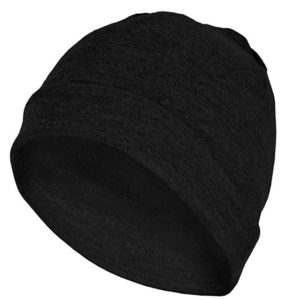
PROS: 100% superfine merino wool. Long enough to cover your ears. Warmest lightweight beanie I’ve had on my head to date.
CONS: I can’t think of one.
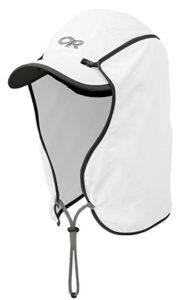
PROS: Lightweight, comfortable, ventilated, snap-on sun skirt.
It fully protects the neck, ears, and side of the face from the sun.
I like that you can unclip the sun skirt and only use it when needed.
CONS: Looks kind of dorky.
Sea to Summit Mosquito Headnet -1 oz-
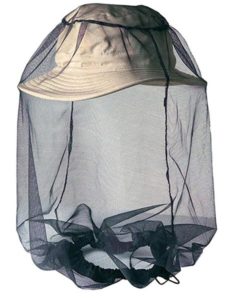
PROS: Keeps the bugs off your face. Wide enough to wear with a hat.
CONS: Have to look through the mesh when you wear it.
DEET is one of the most toxic substances on the planet, and I do everything I can to avoid it. Putting something on your skin that can melt plastic might not be in our best interests.
This is the most valuable piece of bug protection I own.
Ultralight Footwear for Backpackers
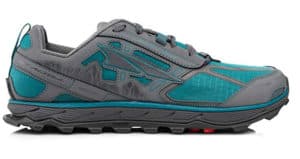
PROS: Breathable, lightweight, thick cushioning where you need it most. The front of the shoe is shaped like an actual foot.
CONS: Altra will change the way their shoe fit-out of nowhere between new models.
Darn Tough 1/4 Ultra Light Sock
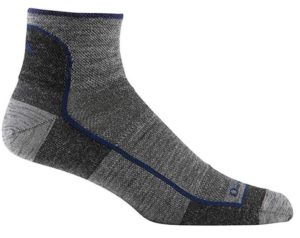
PROS: Nice fit, comfortable, moisture-wicking.
The lifetime warranty is no joke. Darn Tough has always given me full credit to buy new socks after I have worn through them.
CONS: I can’t say a bad thing about these.
Darn Tough 1/4 Hiker Cushion Sock
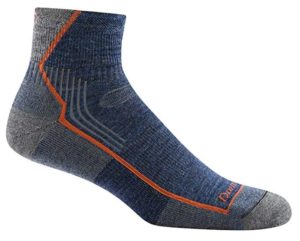
I bring a pair of these slightly thicker socks on all trips. They are always kept clean and dry and are reserved for sleeping.
The Ultimate Trekking Pole
Black Diamond Alpine Carbon Cork -17 oz-

PROS: Lightweight. Good strength to weight ratio. Comfortable cork grips.
The cork grips are nice when your hands get sweaty, and they don’t leave black stuff all over your hands like other trekking poles I have tried.
CONS: Still breakable.
DATA: These are known by many as the best trekking poles out there.
The cork grips are nice when your hands get sweaty, and they don’t leave black stuff all over your hands like other trekking poles I have tried.
A friend of mine managed to break one of my poles. I sent Black Diamond a photo of the broken pole, and they sent me a new pair, no questions asked.
Snow & Winter Gear to Supplement 3 Season Hikers
This is the gear I use for snowy winter conditions. Some of this gear is used year-round if I encounter snow or colder conditions.
I will have a separate page dedicated to the gear I use for mountaineering and more intense 4 season conditions.
MSR Lightning Explore Snowshoes – 3 lbs 14 oz-
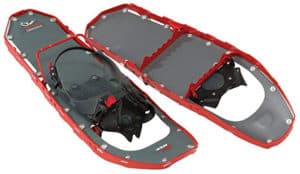
PROS: 360-degree traction frames. The heel lift bar makes climbing steep terrain easier. Ratchet style binding makes getting in and out of binding a breeze.
CONS: Strap can pop out of ratchet.
The MSR lightning ascent snowshoes were my go-to before deciding to give these a try.
Essentially they are the same snowshoes with different bindings.
The bindings on these are much more comfortable and way easier to get in and out of. This is especially helpful when trying to strap in and out of your snowshoes with a heavy bag on.
I have had my strap pop out of the ratchet a few times randomly. I’ll be sending these back to MSR to get that fixed once this snow season is over.
Kahtoola Microspikes -13 oz-
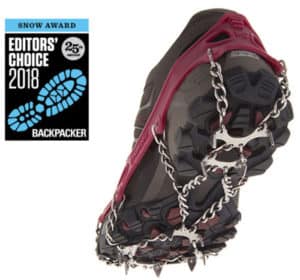
PROS: Provides excellent traction on Icy surfaces. Easy to put on.
CONS: Heavy.
Petzl Glacier Literide Ice Axe -11.2 oz-
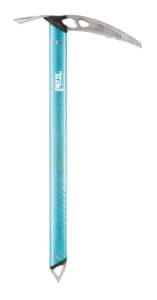
PROS: Lightweight, Great self-arrest performance. Photos look more extreme with an ice ax strapped to the back of your bag.
CONS: I rarely end up actually using this thing when I bring it.
That said, it’s always in my hand while traversing steep snowy terrain.
SnowClaw Shovel -6.1 oz-
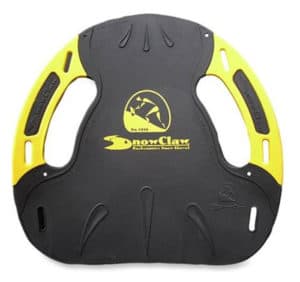
PROS: Takes up little space in the bag. Makes for a nice mini sled.
This thing is great. I use it to build snow caves, and I take this on all of my snow camping trips.
If your butts small enough, you can use them as a mini sled.
CONS: Not a full-sized shovel.
WM Flash Down Pants -6.5 oz–
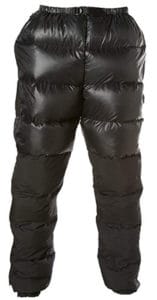
PROS: Insanely Warm. Reinforced seat. Built-in belt.
These make hanging around camp in cold temps so enjoyable. I also wear these to bed, adding a ton of warmth to my sleep setup.
CONS: I didn’t buy these soon enough.
WM Down Booties -6 oz-
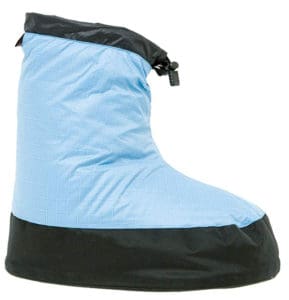
PROS: Extremely Warm. Lightweight & compact.
These are the very first things I put on when I get to camp. My feet always warm up no matter how cold it is.
CONS: Not very good traction on icy snow.
Darn Tough Mountaineering Socks
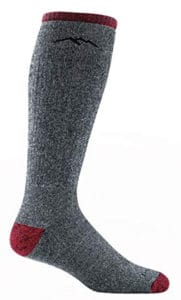
PROS: They keep my feet warm in the coldest conditions.
Darn Toughs warmest pair of socks. I put these on when I arrive at camp. They keep my feet plenty warm when I’m standing around in the snow.
CONS: Heavy.
Darn Tough Mountain Top Light Socks
PROS: Thin. Fast Drying.
Sweat kills. Snowshoeing with a full backpack is some serious work.
I wear these socks on the hike in and out to minimize sweat.
CONS: Too perfect.
MLD Light Snow Gaiters -2.3 oz-
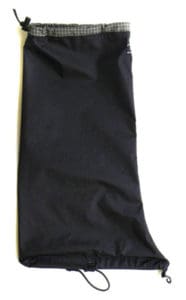
PROS: Lightest waterproof snow gaiter available.
I love the simplicity and lightweight design of these. By far my favorite snow gaiter I’ve tried out so far.
CONS: I have to take the shoe off to put these on and take them off.
Join the 1,000 + Member Hiking Community 🙂
Emails are never shared. Unsubscribe at any time.
Disclosure: This page contains affiliate links. This adds no extra cost to you, but I may receive small commissions for purchases made via these links.
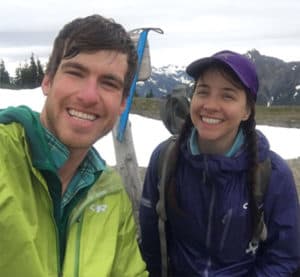
This helps me eat and keep this site running.
I really appreciate the support.
PS: Leave a comment here if you have any questions.
I’m always happy to answer them. 🙂
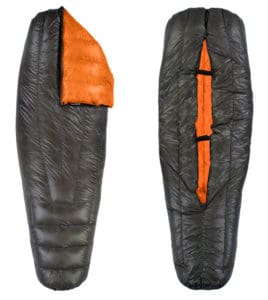
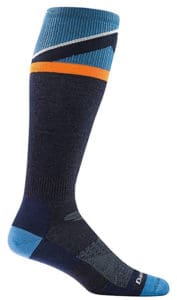
Iron,
I just discovered your YouTube and site. Thanks for the great resource, you’ve got yourself a long term sub! I typically do one 5-6 day trip per year in the Eastern Sierras (late summer). Nice to know many of my gear choices already line up with someone with a lot more mileage on the odometer.
I’m in the market for some new shell pants. I’ve traditionally used a soft shell pant but it is heavy and not ideal as a rain pant (nor am I excited about carrying multiple pairs of pants). I see some guys only using a base layer under their shorts (perhaps with a rain shell packed away). I just don’t know that I’m ready to take that leap. Any suggestions? I was thinking maybe the Marmot Minimalist. I don’t get a ton of rain, so my primary concerns are wind and warmth around camp, and of course emergency rain use. I’m usually in the 20-30 degree range at night.
Thanks!
Hey Josh,
Thanks a ton. I have been a big fan of the Outdoor Research Helium pants. They are lightweight, super comfortable & do a great job of blocking the wind and adding a little bit of warmth, and of course keeping your legs dry. I even use them as my shell on my snowshoe trips in some pretty cold conditions. Hope that helps. Happy trails buddy.
Hi, great info on your site! Debating between the hyperlite 4400 or 3400. Do you think all your stuff would have fit into the 3400? Also I’m thinking of using either a peak design capture clip or cross chest bag for my camera (d750) which may help distribute the weight of the load. Have you tried either? Thanks!
Hey Carl,
Thanks so much.
My 4400 bag is maxed out on my longer trips.
If you’re on the fence I’d highly recommend going with the larger size. It compresses down no problem & doesn’t weigh much more than a 3400…
Personally I have come to like carrying my camera in a camera case thats easily accessible at the top of my bag. Carrying it on my body takes away from the hiking experience it’s self.
Happy Trails,
Iron
I don’t get this current fad for tiny packs. As you say, the weight penalty for a more generous capacity is minimal, and with a decent compression system you get a lot of extra flexibility for virtually no penalty.
That way, you can use one pack for everything from summer day-walks to winter touring. Compared to owning a quiver of different specialised packs, your approach is simpler and cheaper. I’ve been doing this for decades and it just works.
Ah – but you don’t get any bragging rights in the pissing contests around the campfire. But frankly, I’ll leave that to the fashion victims – function first!
Sounds like you have been around the block my friend!
I agree 100 percent with one exception… Doing a long distance thru hike where those few ounces might matter.
Happy trails buddy!
Hey Irontazz! I can’t stop reading your website, so many good tips on lightening the load. I can tell you have a ton of experience and are an expert when it comes to all things backpacking. I just wanted to ask about the disclosure at the bottom of the article. I really trust your gear recommendations so I wanted to make sure the gear you recommend on your site, isn’t just being recommended because of the possibility of making money off commission. I totally get we all need money to live, eat, and go on these awesome adventures! I just want to make sure I’m taking the absolute best gear out with me, and I hope your website is unbiased in the sense that it only promotes gear that’s in the best interest of future backpackers. Again really respect what you have accomplished, not only in the sense of adventuring around the world, but also, this is just an awesome site. But I do think it’s a fair question. Thanks
Sincerely Casey
Hey Casey!
Really happy you are finding value on my website.
I think that is a beyond fair question.
There is an insane amount of people recommending products purely because of the money they can make from doing so.
Lots of sellouts.
Morally that doesn’t sit right with me.
I wan’t this platform to be as unbiased as possible.
Everything I recommend, I use personally and think it’s the very best gear out there for my style of hiking.
I do receive a commission for some of my affiliate links.
I also don’t receive any commissions for a lot of my recommendations.
I wan’t this platform to help as many people as possible.
Always my number one goal.
Thanks for bringing up this important topic & thanks for the beyond kind words.
Happy Trails,
Iron
I’m no expert but I have experience with much of the gear recommended on this site. Wile I’ve made slightly different choices in some areas, I think these recommendations are solid and wouldn’t hesitate to trust any of the gear linked here.
Thanks a ton my friend!
Many years ago I switched from moleskin to Spenco Adhesive Knit for my footcare.
It has construction like burlap weave so it breathes better. I can leave it on my feet 2-3 days. Consider it.
Thanks for the awesome insight Joe.
Much appreciated!
Iron Tass,
I’m always debating with myself over carrying my R-1 or Ghost whisper on spring and fall outings. I prefer the Ghost Whisper it’s half the weight but I’m afraid my pack straps will wear a hole in the shoulders or get wet if it rains. I like your idea of the Marmot fleece for weight savings. I could carry both but that just seems like over kill. What are your thoughts?
John aka Capt. America
Hey Capt. America!
That’s a really good question…
I was in a similar situation before I found my Marmot fleece.
What area are you going to be hiking in?
If it were me I’d bring both if there was a possibility of some SERIOUS weather (Lots of rain in colder temps).
Little or no rain in the forecast? I’d feel more than comfortable with just the Ghost Whisperer.
Iv’e worn my Ghost Whisperer countless times while hiking with my backpack on and have had no issues with holes.
Hope this helps.
Hey Iron amazingly honest and useful review. Love it! I own some of the stuff you have and I 100% agree with your comments.
I have a couple questions: eventually once my backpack dies I plan on buying the Hyperlite one you recommend, you didn’t mention much on how it fits, have you ever had any issues after several days of weight on you? Since it is such a simple design.
Also, I am looking into the Altra Lone Peak Neo High Top’s, I am really drawn to how light the shoe is since I hate bulky hiking shoes. I read on a review that these shoes are not totally water proof. Have you found that they get wet very easily? or can I trust that I won’t be walking around with wet feet under the rain? In this case, do they dry fast?
Thanks again for your information, it is really helpful!!. Love what you do man and I am definitely following a lot of tips you are putting together for future trips!
Hey Maximo!
I just did a in-depth review on my backpack on my YouTube channel. 🙂
Altra Neo High Tops:
They are waterproof to an extent…
In my experience they will wet out after a bit.
I think you are better off with the NON Neo Altra’s for hiking in rain (The Neo versions do take longer to dry once wet).
They aren’t as breathable and your feet will sweat more in the Neo’s as well.
I find the Neo’s to be ideal as a lightweight snow shoe and that is the only time that I personally wear mine.
Thanks for the kind words!
Happy Trails.
Very nice list; thanks so much for sharing! I was pleased to see you & I have a lot of the same gear. Can you share what your gf’s clothing choices are in the future — maybe in a supplementary link — for female hikers? Also, where is the camping spot in your photo near the top of this page? That view is awesome! Thanks again!
Thanks so much Claudia,
Sounds like you have some awesome gear!
I’m glad you brought that up, the thought crossed my mind when I was putting this guide together that I should possibly include that info. I’ll be sure to give this guide a revision with a list of her clothing when I get the chance.
That said, me and Trish have an almost identical clothing layering system. With the exception of her clothing being XS or the female version if it’s available.
That photo was captured in the Pickets, North Cascades.
Thanks again & Happy Trails!
Thank you so much for such an honest, comprehensive run down on great gear. Im new to backpacking and bushcraft but know that i need dependable gear such as you have described. One of the best articles ive read in a long time. Thank you so much.
Thanks for the kind words, my friend:)
You’re very welcome.
Hope you’re having a blast out there!